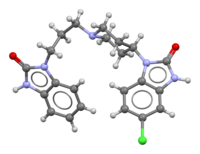
Photo from wikipedia
This study aimed to evaluate the QT prolongation potential of domperidone in healthy Chinese participants and explore the possibility of a thorough QT (TQT) study in China with a smaller… Click to show full abstract
This study aimed to evaluate the QT prolongation potential of domperidone in healthy Chinese participants and explore the possibility of a thorough QT (TQT) study in China with a smaller sample size using concentration‐QT (C‐QT) modeling. Part 1 was a randomized, placebo‐ and positive‐controlled, multiple‐dose, 4‐way crossover TQT study in healthy Chinese participants; 44 participants were randomized to either domperidone 10/20 mg or placebo 3 times daily, on days 1 to 3, followed by a single dose of either 10/20 mg domperidone/domperidone‐placebo/domperidone‐placebo plus 400 mg of moxifloxacin, on day 4. Twelve‐lead electrocardiograms were recorded in triplicate at predefined time points with pharmacokinetic sampling. The results were that change from baseline in QT interval corrected for heart rate (QTc) using the Fridericia formula (QTcF) between domperidone and placebo was 1.3 milliseconds and 2.7 milliseconds for 10 and 20 mg 3 times daily, and upper limits of 2‐sided 90%CI for all time points were below regulatory threshold of 10 milliseconds. In part 2, resampling analysis using C‐QT modeling for moxifloxacin showed false‐negative rates of <5% with sample sizes ≥6. We could conclude that no clinically relevant effect on corrected QT interval or new safety signals was observed with domperidone. A dedicated TQT study with C‐QT modeling could assess drug effects on QT/corrected QT intervals for novel drug development in China.
Journal Title: Clinical Pharmacology in Drug Development
Year Published: 2022
Link to full text (if available)
Share on Social Media: Sign Up to like & get
recommendations!